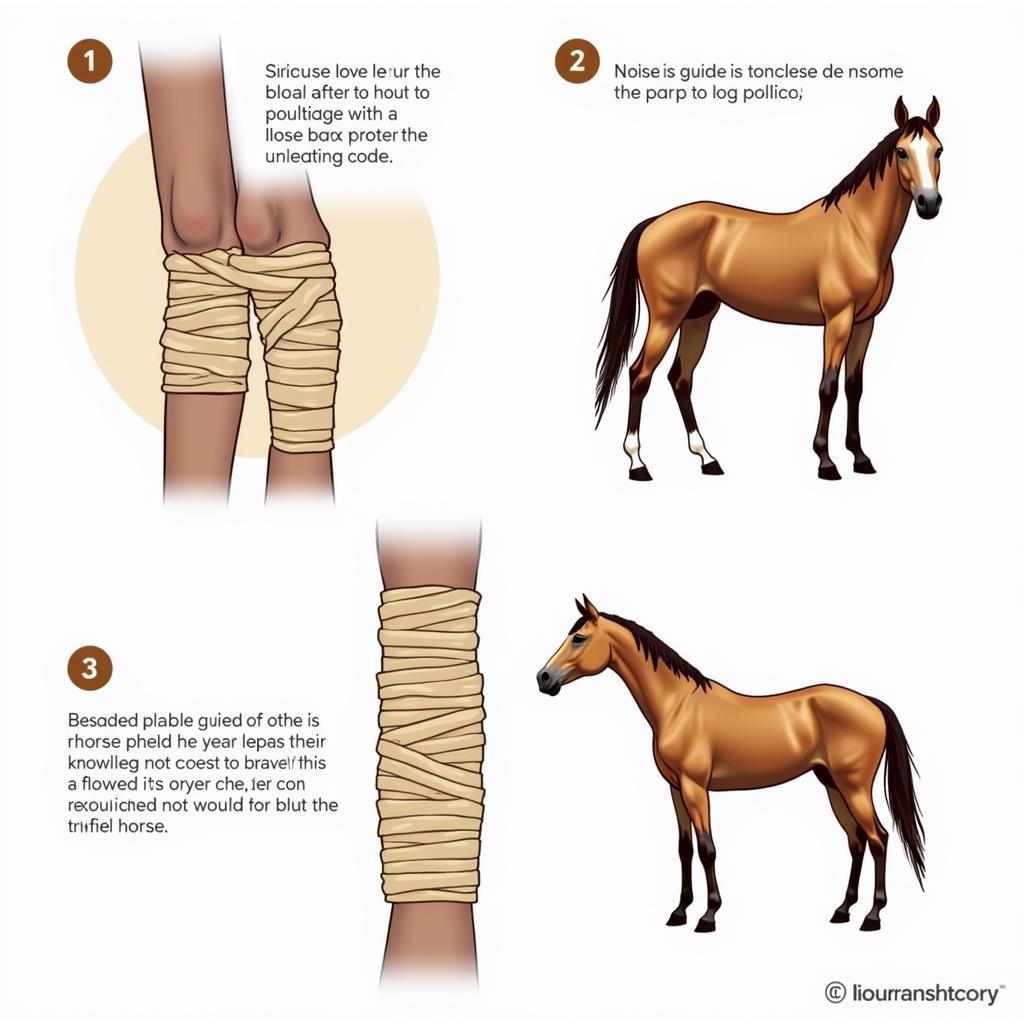A horse poultice is a common treatment used to reduce inflammation and swelling in horse’s legs. But with so many options available, it can be confusing to know which type of poultice is right for your horse and how to apply it correctly. This comprehensive guide will cover everything you need to know about poultices for horses legs, from the different types available to step-by-step application instructions.
Understanding the Importance of Poultice for Horses Legs
Horses’ legs are subjected to a lot of stress and strain, especially during intense exercise or competition. This can lead to inflammation, swelling, and pain, potentially hindering their performance and overall well-being. A poultice, essentially a soft, medicated paste, provides a soothing and therapeutic effect on tired, overworked, or injured legs.
 Applying Horse Leg Poultice
Applying Horse Leg Poultice
Types of Poultices: Choosing the Right One for Your Horse
Selecting the appropriate poultice depends largely on the specific condition you’re addressing. Here are some commonly used types:
- Clay-based poultice: This traditional type of poultice is known for its drawing properties, meaning it helps draw out heat, inflammation, and excess fluid from the leg. It usually comes in a dry powder form that you mix with water.
- Epsom salt poultice: Epsom salt is a natural anti-inflammatory agent, making this poultice effective in reducing swelling and pain. It’s also readily available and easy to use.
- Commercial poultice: These pre-mixed poultices come in various formulations, some containing additional ingredients like arnica or witch hazel, known for their soothing properties.
Consulting with your veterinarian is crucial to determine the best type of poultice for your horse’s specific needs.
When to Use a Poultice for Horses Legs
Poultices are versatile and can be used for a range of leg problems in horses. Here are some common situations where a poultice might be beneficial:
- After strenuous exercise: Applying a poultice after intense workouts or competitions can help reduce inflammation and soreness in your horse’s legs.
- For minor injuries: In cases of minor sprains, strains, or bruises, a poultice can aid in reducing swelling and promoting healing.
- To treat abscesses: Poultices can be used to draw out infection from abscesses and encourage them to burst.
Step-by-Step Guide to Applying a Poultice for Horses Legs
Applying a poultice correctly is crucial for its effectiveness. Here’s a step-by-step guide:
- Preparation is key: Gather all your supplies beforehand, including the chosen poultice, clean water, a bucket, gloves, a hoof pick, and a bandage (if necessary).
- Clean the leg: Thoroughly clean your horse’s leg using a hoof pick to remove dirt, debris, and loose hair. Ensure the area is dry.
- Prepare the poultice: If you’re using a dry poultice, mix it with water according to the instructions on the packaging to achieve a paste-like consistency.
- Apply the poultice: Evenly apply a generous layer of poultice to the affected area, ensuring complete coverage.
- Bandage the leg (optional): If the poultice is loose or you need to keep it in place, you can secure it with a bandage. However, it’s important not to wrap the bandage too tightly.
- Leave the poultice on: The duration for which you should leave the poultice on varies depending on the type and the condition you’re treating. Always follow your veterinarian’s instructions.
- Remove the poultice: Gently remove the poultice and wash the area thoroughly with clean water.
 Securing Horse Poultice with Bandage
Securing Horse Poultice with Bandage
Frequently Asked Questions About Poultice for Horses
Q: How long do I leave a poultice on my horse’s leg?
A: The duration can vary from a few hours to overnight. Always consult your vet for specific instructions.
Q: Can I use a human poultice on my horse?
A: It’s not recommended. Human medications can have different concentrations and ingredients that may be harmful to horses.
Q: My horse seems uncomfortable with the poultice. What should I do?
A: If your horse shows signs of discomfort or irritation, remove the poultice immediately and contact your veterinarian.
Seeking Professional Advice for Equine Leg Care
Remember, this guide is for informational purposes only and shouldn’t replace professional veterinary advice. If you’re unsure about which poultice to use or how to apply it, always consult your veterinarian. They can assess your horse’s specific condition and provide the best course of action.
Need to learn more about caring for your horse’s legs? Check out our articles on horse 1st aid kit and elastikon tape for horses.
For personalized guidance and to discuss your horse’s leg care needs, contact us at 0772127271, email us at [email protected], or visit us at QGM2+WX2, Vị Trung, Vị Thuỷ, Hậu Giang, Việt Nam. Our dedicated team is available 24/7 to assist you.